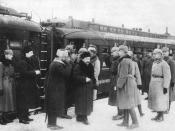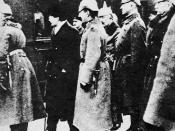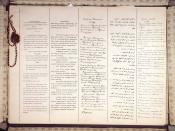The Bolshevik Party had seized control with the Revolution of November 1917. However, in the following period, opposition increased as a result of Bolshevik actions. These groups would be part of what was to be the greatest threat to the Bolsheviks. This led to a power struggles within Russia and hence, the Civil War of 1918-21.
Since Russia's involvement in World War I had adversely affected the country both economically and socially, Lenin believed that ending the war would ensure the Bolsheviks' survival. The Treaty of Brest-Litovsk with Germany in 1918 ended the war, but included losses such as one-sixth of the Russian population and over 70 percent of its iron ore and coal. It became a springboard for increased opposition. Social Revolutionary leftists, for instance, wished to continue fighting and opposed the harsh terms of the treaty. While the Bolsheviks had rivals before Brest-Litovsk was drawn up, the intensified situation seemed to ensure future confrontation between the opposed parties.
This confrontation would indeed take place in the same year.
Opposition outside of Russia increased in direct relation to the creation of Comintern in 1919. Communist ideology was subversive toward capitalism, stating that conflict between the opposed systems was inevitable. Britain, the US, and France recognized this as a threat; thus, they supported the Whites to overthrow the Bolsheviks. Foreign powers had entered the conflict, contributing to the development of the civil war. Another form of opposition was the Czech Legion, previous soldiers of the Austria-Hungary army. In 1918, they were leaving Russia for the East, but mutinies occurred and Trotsky ordered them to give up their arms. The Legion resisted, took over the Trans-Siberian Railway, and later joined the Whites against the Reds in the civil war.
From 1918-19, the Bolsheviks found themselves faced...


